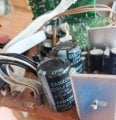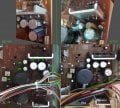Hello everyone,
I have a noob question, about (potentially) a PSU in a 5.1 audio / video receiver (from 2002 or so): Thomson DPL660HT (find technical manual here)
A few days ago, as strong summer started here, a hum started coming out of the front left speaker. Switching the cable (front left for front right) made the hum move to the other speaker, so that eliminated cable or speaker issue.
After opening the unit, I noticed a monster capacitor bulged. It was a 8200uf 63v one (I assume it belongs to the PSU as it's next to the animal transformer), on the main board. There was this and another twin 8200uf cap. The other one looked ok (although now I regret not checking it better).
After searching for a replacement and failing, I decided to try my luck and bought a 10000uf one (once again, I regretted right after, but regardless, nobody sells here 8200uf ones so it was that or nothing). See bulged cap in the photos below. Narration continues after:




After replacing it (worst nightmare ever given the burger-town design of this machine with multiple levels of boards and cables connecting everything to everything (literally, seriously, even though some boards are slotted to each other) the fix was done.
First day: no hum, all speakers good. Happiness.
Second day: gentle hum for a few seconds, then no more hum.
Forth day (or so): switch on immediately caused a switch off ("hello" .... "goodbye" shown in the display) with a not nice loud bang coming out of at least one speaker. This "little" issue happened 3 or 4 times until I quickly repeated the switch on action a few times and then it stayed on and came back to normal. The bang is randomly happening on one or another speaker, or not at all. The hum starts low, and gradually rises till an obvious level. After some 10 / 20 seconds it may abruptly disappear. It may gradually come back, then disappear. After a minute or so, it's totally gone.
Now my questions:
- Can the issue be related to me placing a 10000uf capacitor instead of a 8200uf? (voltage is the same, 63v). I'm particularly scared of the auto off situation.
- The unit has always been very hot in summer: can this be the root cause? Inside it has 2 very small fans that spin at not too high speed (I checked the caps in the fan board and the 3 of them seem to be good; maybe I should replace a resistor that controls the speed... Maybe not...!) Nevertheless I was planning on adding a big PC fan (whether internally or outside the case, to suck the hot air out through the vents) with an external PSU (don't wanna mess anything further).
- A crystal in the radio board (see 1st pic, middle-left area, floating board) was totally goodbye (see its black contents under it) and came off when accidentally touching it: can this missing component be causing a short or something? (I don't use the radio function, so it doesn't really bother me otherwise).
Thank you all very much for your time and help, any idea is greatly appreciated!
I have a noob question, about (potentially) a PSU in a 5.1 audio / video receiver (from 2002 or so): Thomson DPL660HT (find technical manual here)
A few days ago, as strong summer started here, a hum started coming out of the front left speaker. Switching the cable (front left for front right) made the hum move to the other speaker, so that eliminated cable or speaker issue.
After opening the unit, I noticed a monster capacitor bulged. It was a 8200uf 63v one (I assume it belongs to the PSU as it's next to the animal transformer), on the main board. There was this and another twin 8200uf cap. The other one looked ok (although now I regret not checking it better).
After searching for a replacement and failing, I decided to try my luck and bought a 10000uf one (once again, I regretted right after, but regardless, nobody sells here 8200uf ones so it was that or nothing). See bulged cap in the photos below. Narration continues after:




After replacing it (worst nightmare ever given the burger-town design of this machine with multiple levels of boards and cables connecting everything to everything (literally, seriously, even though some boards are slotted to each other) the fix was done.
First day: no hum, all speakers good. Happiness.
Second day: gentle hum for a few seconds, then no more hum.
Forth day (or so): switch on immediately caused a switch off ("hello" .... "goodbye" shown in the display) with a not nice loud bang coming out of at least one speaker. This "little" issue happened 3 or 4 times until I quickly repeated the switch on action a few times and then it stayed on and came back to normal. The bang is randomly happening on one or another speaker, or not at all. The hum starts low, and gradually rises till an obvious level. After some 10 / 20 seconds it may abruptly disappear. It may gradually come back, then disappear. After a minute or so, it's totally gone.
Now my questions:
- Can the issue be related to me placing a 10000uf capacitor instead of a 8200uf? (voltage is the same, 63v). I'm particularly scared of the auto off situation.
- The unit has always been very hot in summer: can this be the root cause? Inside it has 2 very small fans that spin at not too high speed (I checked the caps in the fan board and the 3 of them seem to be good; maybe I should replace a resistor that controls the speed... Maybe not...!) Nevertheless I was planning on adding a big PC fan (whether internally or outside the case, to suck the hot air out through the vents) with an external PSU (don't wanna mess anything further).
- A crystal in the radio board (see 1st pic, middle-left area, floating board) was totally goodbye (see its black contents under it) and came off when accidentally touching it: can this missing component be causing a short or something? (I don't use the radio function, so it doesn't really bother me otherwise).
Thank you all very much for your time and help, any idea is greatly appreciated!






